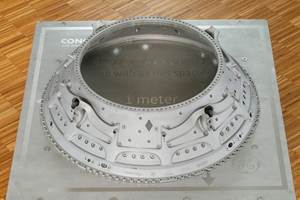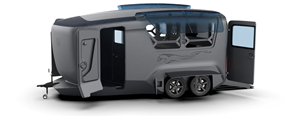Enabling Sustainable Production Through Measuring Energy Data
Airbus subsidiary CTC’s mobile technology measures machine energy use on new machines and helps optimize for sustainability and efficiency. Valuable for AM applications targeting sustainability.

Developed by CTC, a composites manufacturing R&D subsidiary of Airbus, the PERU’s first uses are, of course, for measurement and optimization of Airbus composites manufacturing processes. However, CTC is working both in-house and with customers to showcase the tool’s use for polymer 3D printing as well as metal machining, welding, painting and other processes. Source, all images: CTC GmbH
“There are many different practical reasons that companies across industries are looking into energy savings in their operations these days, beyond just simply wanting to be more sustainable,” says Jan Ohm, project leader at the Composite Technology Center / CTC GmbH (Stade, Germany), a 100% subsidiary of Airbus. Some customers, required to perform life cycle assessments (LCA) on their end-use products, may directly ask for energy usage data from their supply chain. Reducing energy usage also naturally reduces associated energy costs, often resulting in optimized machines that are more efficient and may require less maintenance.
Regardless of the reason, measuring and understanding energy usage in operations is increasingly important.
As reported by CompositesWorld Senior Technical Editor Ginger Gardiner in an article about the development of this technology, CTC developed a modular, portable system that enables better measurement and analysis of energy use across machines and production lines. Called the portable energy recording unit (PERU), the system supports simultaneous recording from a machine or system as well as its components, such as individual motors or heating elements. As a result, it can help identify potential energy savings and optimize operations. For example, after what time is it better to turn a machine off and on than to let it run in standby mode?
As Gardiner reports, the technology was first used to evaluate several composites fabrication processes, and it is being used by Airbus to improve machine control systems and tooling approaches and to guide materials, process and equipment decisions for future airframes.
However, the PERU technology was developed with the knowledge that its use could be beneficial for evaluating a wide range of manufacturing and assembly processes, from polymer or metal 3D printing to metal machining to painting and more. Additive manufacturing in particular has great potential for benefiting from this type of data and evaluation — as additive is often pursued as or claimed to be a more sustainable or efficient alternative to traditional manufacturing processes, being able to accurately measure and compare this information could be invaluble to both 3D printer suppliers and customers.
The technology has already been used in several projects in these areas, says Ohm, with potential for expansion into new areas.
The PERU System
As Gardiner reported, CTC’s development of energy measurement technology started with a request from colleagues at a nearby Airbus plant that manufactures vertical tail planes from fiber-reinforced composites. Ohm says, “The energy requirements are not yet clear down to the last machine level. It is therefore necessary to describe and classify energy consumption from building level down to component level. Most of the machines were acquired before energy measurement became so relevant and didn’t have adequate measuring capability built in. We needed a system that could measure the power use in the machines, but also something that was easy to use — not just the hardware but also the data collection.”
Ohm and his team researched what was state-of-the-art and available in measuring systems, and realized that currently available devices were limited in the amount and type of sensors they were compatible with. He says, “If you have multi-current power — which is common with big systems — you would be able to see that machine’s energy use on an overall level but not what is happening within its components.” The team decided this wasn’t sufficient, and set out to develop a new concept.
The result is the portable energy recording unit (PERU), which sits in a case and measures 1 × 1.5 meters. At its heart is a programmable logic controller (PLC), which enables connection to a wide range of sensors and inputs, for measuring volume flow, vacuum, pressurized air or other metrics.
The PERU system can currently measure electrical use of up to five machines or machine components at once, and can integrate a variety of other sensors. Pictured here, the standard system uses Rogowski coils to measure electrical current, and the system runs on battery power.
A simple app was developed using Matlab software (MathWorks, Natick, Mass., U.S.) that gives a quick plot as a starting point. “For this, we plot every needed channel: electrical current, energies and flow measurements above the time,” explains Jannis Eckhoff, project manager at CTC.
“We can also do detailed analysis, where we can show interactions between different components in the machine. We can calculate the overall machine energy consumption, and then zoom in and analyze how it is composed from different components. For example, we identified a machine in which the cooling and heating components worked against each other in a non-constructive way, resulting in unnecessary energy consumption.”
He notes there are also other effects. “When we couple our energy data with process data, like pressure, we can provide even further analysis. For example, we can match energy peaks and overall consumption with information from the process and can diagram how the process uses energy and by which machine components.”
“When we couple this again with information from our flow sensors, we can get information about other forms of energy like thermal flows, i.e., heating and cooling,” adds Eckhoff. “Or we can add in displacement sensors and correlate this data with machine movements. Then we can analyze how efficient the machine is and we can optimize the process to increase energy efficiency.”
This data can also be used for other types of analysis with different level of details. “We can analyze the process, for example, to see energy usage during machine startup, operation and shutdown,” says Eckhoff. “And then we can compare this with standby consumption when the machine is left on without processing [e.g., parasitic draw] and make decisions on when to turn the machine off based on real data, not just assumptions. We can also look into the different components during each of those phases and help optimize the process and equipment operation.”
Ohm notes that his team has been able to identify energy savings from 20-30% for multiple customers using the PERU and this type of data analysis. (See Gardiner’s original article in CompositesWorld for more on the use of PERU to evaluate and optimize composites processes and aerospace structures).
Multi-Industry Use Cases: Polymer 3D Printing, Extrusion, Metal Machining, Paint and More
“Part of the original goal was to be able to adapt the technology to complex production machines, regardless of what kind of machine and what manufacturing sector,” says Ohm. “But not only is the technology itself adaptable, but also the analysis the data ends up going into applies to any industry, whether it’s a simple analysis, an LCA, or a complex process analysis — it’s all quite straightforward to apply this to any industry.”
Additive Manufacturing (AM)
For example, one internal project the company has worked on is measuring the energy output of an industrial-grade fused deposition modeling (FDM) polymer 3D printer and a select laser sintering (SLS) printer. Eckhoff explains, “When you’re talking about life cycle analysis, you have to start from a life cycle inventory, which is the actual frontline data to be analyzed. So we wanted to build up this baseline data for our printer.”
The PERU’s default reporting is a simple Matlab app with two plot channels to show energy measurement (top image). The system can also be used to plot more in-depth analyses. The bottom image shows energy measurements for different components in the same machine.
This process involved setting up the PERU system’s sensors to analyze each process step during printing — “We want to be able to break it down, to say what is the energy used to start the print job, what is the energy you use for specific layers or specific volume, and what is the energy used at the end of the process,” Eckhoff explains. “If you run multiple printers, you could run studies to see which consumes the most energy on standby mode or see what the energy consumption pattern is for a specific part built on different printers, whatever is of interest for a particular project or company. Or you could compare 3D printing to a more traditional manufacturing process.”
An important part of this, Eckhoff notes, is the ability to use this data to build digital process models. “If we’re trying to improve the ecological footprint, we need to be able to figure out the most energy-efficient method of manufacturing a part without actually spending the energy and material to build test parts over and over. It’s important to be able to build up digital models as much as you can.”
The team has also discussed use of PERU for other types of 3D printing systems, including metal 3D printing, in the future.
For evaluating different processes and materials, Ohm notes, it can be necessary to use different sensors. “For example, for sandblasting, in addition to general electricity usage, it’s relevant to use a flow rate sensor to capture the compressed air flow.”
Metal Machining, Industrial Painting
Another industry area CTC has worked on internally is the use of the PERU to measure CNC milling machines or drilling machines during metal part assembly.
The company has also used the system to measure the energy used by industrial paint systems within a manufacturing company’s paint shop.
Welding, Assembly and Beyond
In addition to analyzing energy consumption by individual manufacturing processes, the CTC team is also working on its use to evaluate ultrasonic welding of plastic, composite or metal parts, and metal assembly processes such as drilling machines.
“We performed an in-house study using our ultrasonic welding capabilities, in this case looking at plastic components welded together,” Ohm explains. “The robot and end effectors could of course be switched out to accommodate metals welding or other materials. Ultimately, we want to be able to measure energy consumption at each stage of the process for every part — manufacturing and assembly — to get the best picture we can to inform future decisions.”
In addition, while CTC’s Airbus affiliation makes aerospace a natural first target end market, the company is working with others to expand the technology into other sectors like the railway and maritime industries.
An example of the PERU showing measurements of energy use in different phases of a manufacturing process.
Important to note is that this data can be used to inform decisions before machinery purchase, by simulating the process and its carbon footprint digitally ahead of time, or to determine how best to optimize an existing machine. Ohm notes, “We need to make sure what we’re building for the future is more sustainable, but also in many cases we need to optimize what we already have. Companies can’t just shut down their operations altogether and replace with all-new machines. So we need to do both — make sure new systems are as sustainable as possible, and optimize what we have today.”
Currently, CTC’s technicians operate the PERU system for customers on a consulting basis. Ohm says the company is also looking into providing customers with the blueprints to construct their own mobile version of the PERU system themselves — or even larger, fixed version — to perform analyses at their own facilities.
Beyond sustainability, optimizing for reduced energy consumption generally also means higher machine efficiency, which translates into cost savings. Eckhoff points out, “Sometimes energy savings, while nice, are not enough of a driver for a company to make an investment on new or modified machines, but it becomes a priority when using less energy also saves money on energy costs.”
More From This Author
Hannah Mason reports about the composites manufacturing industry for CompositesWorld and about sustainability in manufacturing for parent company Gardner Business Media.
Related Content
Alquist 3D Looks Toward a Carbon-Sequestering Future with 3D Printed Infrastructure
The Colorado startup aims to reduce the carbon footprint of new buildings, homes and city infrastructure with robotic 3D printing and a specialized geopolymer material.
Read MoreHow 3D Printing Aids Sustainability for Semiconductor Equipment: The Cool Parts Show Bonus
Hittech worked with its customer to replace fully machined semiconductor trays with trays made via DED by Norsk Titanium. The result is dramatic savings in tool consumption and material waste.
Read MoreGE Additive Helps Build Large Metal 3D Printed Aerospace Part
The research is part of an initiative to develop more fuel-efficient air transport technologies as well as a strong, globally competitive aeronautical industry supply chain in Europe.
Read MoreNext-Gen Horse Trailers to Be Built With Robotic 3D Printing
Double D Trailers is currently developing a prototype horse trailer that will be made with large-format additive manufacturing. The technology brings potential benefits for labor, weight and design features to this subset of recreational vehicles.
Read MoreRead Next
3D Printed Polymer EOAT Increases Safety of Cobots
Contract manufacturer Anubis 3D applies polymer 3D printing processes to manufacture cobot tooling that is lightweight, smooth and safer for human interaction.
Read MoreBike Manufacturer Uses Additive Manufacturing to Create Lighter, More Complex, Customized Parts
Titanium bike frame manufacturer Hanglun Technology mixes precision casting with 3D printing to create bikes that offer increased speed and reduced turbulence during long-distance rides, offering a smoother, faster and more efficient cycling experience.
Read MoreCrushable Lattices: The Lightweight Structures That Will Protect an Interplanetary Payload
NASA uses laser powder bed fusion plus chemical etching to create the lattice forms engineered to keep Mars rocks safe during a crash landing on Earth.
Read More
.jpg;width=70;height=70;mode=crop)











.jpg)














